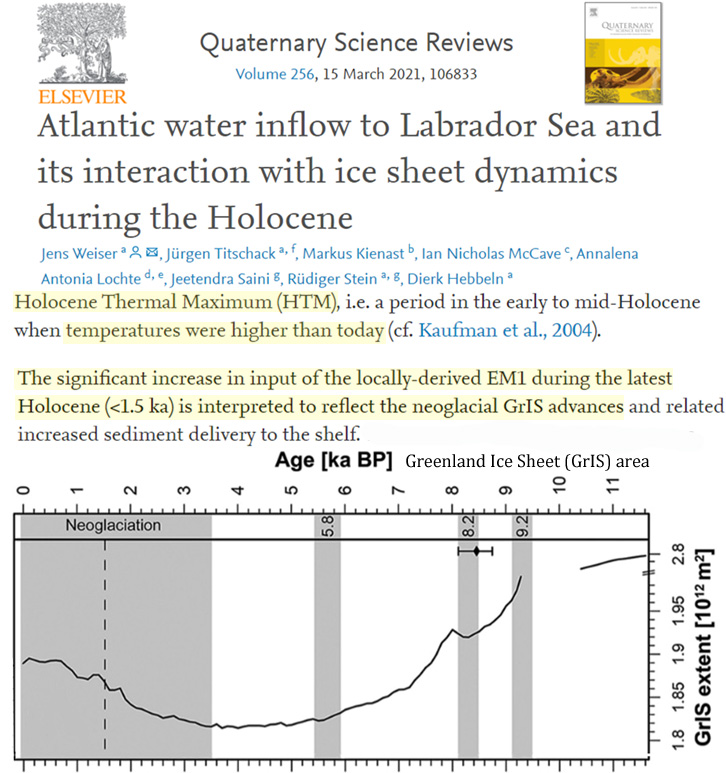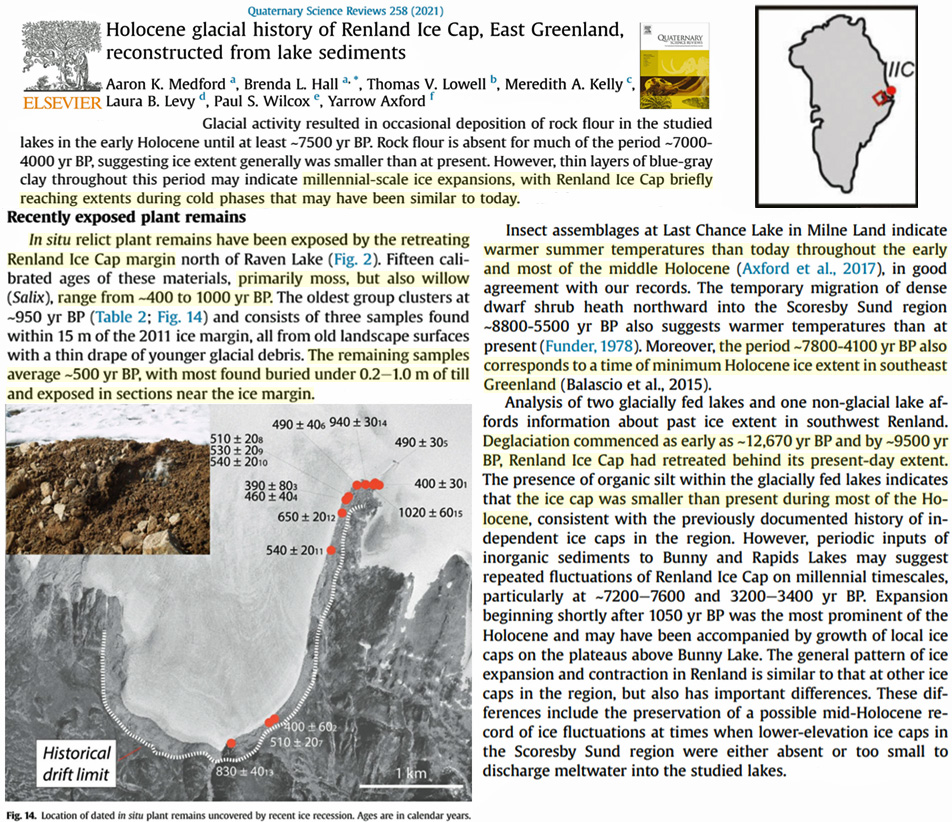Exposed moss and willow shrubs buried beneath today’s receding East Greenland glaciers can be dated to 400 to 500 years ago, suggesting this period (the early Little Ice Age) was as-warm or warmer than today.
It is widely accepted that Greenland’s surface temperatures were several degrees warmer (McFarlin et al., 2018, Axford et al., 2021) and ice volume and extent much smaller (Nielsen et al., 2018, Weiser et al., 2021), throughout nearly all of the last 8,000 to 10,000 years.

Image Source: Weiser et al., 2021
What may not yet be widely accepted is the conclusion that the modern temperatures and ice extent still fall within the range of a Holocene “cold stage” rather than a warm stage.
A new study documents a much warmer-than-today Early and Middle Holocene in East Greenland, a time when ice caps were “absent” or far less extensive than they are presently. Plant remains buried under retreating glaciers in East Greenland affirm these locations were not covered in glaciers as recently as 400 to 500 years ago.
But the authors also report there were occasionally brief “cold stages” during the Holocene when Greenland’s glacier extent advanced to today’s levels.
“…Renland Ice Cap briefly reach[ed] extents during cold phases that may have been similar to today.”
This suggests that the modern temperatures and ice volumes fall within the range of a “cold stage” too.






Came across this recently, describes an event involving the Beaufort Gyre that could result in sudden cooling and is linked by the Studies to the LIA and the Ice Age Coming of the 50/60s. Link below to Electroverse where there is a link to the e360.yale.edu report.
——————-
As reported by e360.yale.edu: Today, the Beaufort Gyre now holds as much freshwater as all of the Great Lakes combined, and its continuing clockwise swirl is preventing this enormous volume of ice and cold-freshwater from flushing into the North Atlantic Ocean. Scientists say the gyre will inevitably weaken and reverse direction, and when it does it could expel a massive amount of icy fresh water into the North Atlantic.
Polar oceanographer Andrey Proshutinsky of the Woods Hole Oceanographic Institution has labeled this anticipated surge of water a “ticking climate bomb,” noting that even a partial flush of that growing reservoir –a mere 5 percent– could temporarily cool the climate of Iceland and northern Europe. A larger outflow would actually threaten to shutdown the Gulf Stream, an event that would see ice age conditions sweep Northern and Western Europe almost overnight.
–The Arctic’s “Ticking Climate Bomb”: Little Ice Age Imminent – Electroverse
–https://electroverse.net/the-arctics-ticking-climate-bomb-little-ice-age-imminent/
[…] Full story here. […]
We already knew about the Mendenhall glacier retreat exposing an ancient forest.
https://www.dailymail.co.uk/sciencetech/article-2451640/Mendenhall-Glacier-melting-reveals-ancient-forest.html
“An ancient forest which is thought to have been hidden for at least 1,000 years has been discovered beneath a melting glacier.
Logs and stumps can be seen underneath the thawing 37 square mile Mendenhall Glacier in Alaska, with some of the trees still bearing roots and bark.
Remnants of the forest have been protruding from the river of ice, which flows into a lake near the city of Juneau for around five decades.
But scientists from the nearby University of Alaska Southeast have noticed more tree stumps popping up in the past year.
The researchers are particularly excited about the discovery because most of the trees are so well preserved with some still in their upright position.
The forest is said to have been shielded from the ice by a tomb of gravel which most likely encased the forest as Initial carbon dating tests suggest that the gravel tomb, which is around 5ft high, may have been formed at least 1,000 years ago.”
Manmade CO2 driven climate change is a scam – more proof
https://www.thegwpf.com/green-taliban-outwit-wests-witless-leaders-and-vows-to-help-fight-climate-change/
“Taliban go green and vow to help fight climate change”
Come on !
We already knew about the Mendenhall glacier retreat exposing an ancient forest.
https://www.dailymail.co.uk/sciencetech/article-2451640/Mendenhall-Glacier-melting-reveals-ancient-forest.html
“An ancient forest which is thought to have been hidden for at least 1,000 years has been discovered beneath a melting glacier.
Logs and stumps can be seen underneath the thawing 37 square mile Mendenhall Glacier in Alaska, with some of the trees still bearing roots and bark.
Remnants of the forest have been protruding from the river of ice, which flows into a lake near the city of Juneau for around five decades.
But scientists from the nearby University of Alaska Southeast have noticed more tree stumps popping up in the past year.
The researchers are particularly excited about the discovery because most of the trees are so well preserved with some still in their upright position.
The forest is said to have been shielded from the ice by a tomb of gravel which most likely encased the forest as Initial carbon dating tests suggest that the gravel tomb, which is around 5ft high, may have been formed at least 1,000 years ago.”
Manmade CO2 driven climate change is a scam – more proof
https://www.thegwpf.com/green-taliban-outwit-wests-witless-leaders-and-vows-to-help-fight-climate-change/
“Taliban go green and vow to help fight climate change”
Come on !
From 1365 BC and from 1250 BC were two very long centennial solar minima. There’s a big warm spike in the GISP2 series then which gets misnamed as the Minoan Warm Period. From 5670 BC (7600 BP) was the start of another grand solar minimum series.
[…] New Study: Retreating East Greenland Glaciers Uncover Plant Debris Dating To The 16th – 17th C… […]